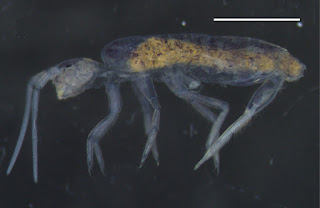Springtails, or collembola, are tiny arthropods. Their size ranges from 0.25 to 6 mm. Springtails normally live in damp soil. They eat mold and fungus.
They get their name from a spring-loaded structure, called the furcula, located on the underside of their abdomen. Most species have an tail-like appendage, the furcula, that is folded beneath the body to be used for jumping when the animal is threatened. It is held under tension by a small structure and when released, snaps against the ground, flinging the springtail into the air. All of this takes place in as little as 18 milliseconds and a jump can cover 10 cm.
Today's new species is actually a cave dwelling collembola discovered in China. It was named after its collector Prof. Mingyi Tian.
For the experts: Two new troglobitic species of Tomoceridae are described from Guizhou and Guangxi provinces, China. Tomocerus tiani sp. n. resembles Tomocerus kinoshitai Yosii, 1954, Tomocerus caecus Yu & Deharveng, 2015 and Tomocerus similis Chen & Ma, 1997 but differs from them mainly in the body colour, the cephalic chaetotaxy and the number of manubrial pseudopores. Monodontocerus cinereus sp. n. is similar to Monodontocerus mulunensis Yu, Deharveng & Zhang, 2014 but is different from the latter in the body colour, the length of antennae, the number of ungual teeth and the chaetotaxy on Abd. III and Abd. IV. Special remarks are made on the mesothoracic bothriotricha in Tomocerinae.

No comments:
Post a Comment